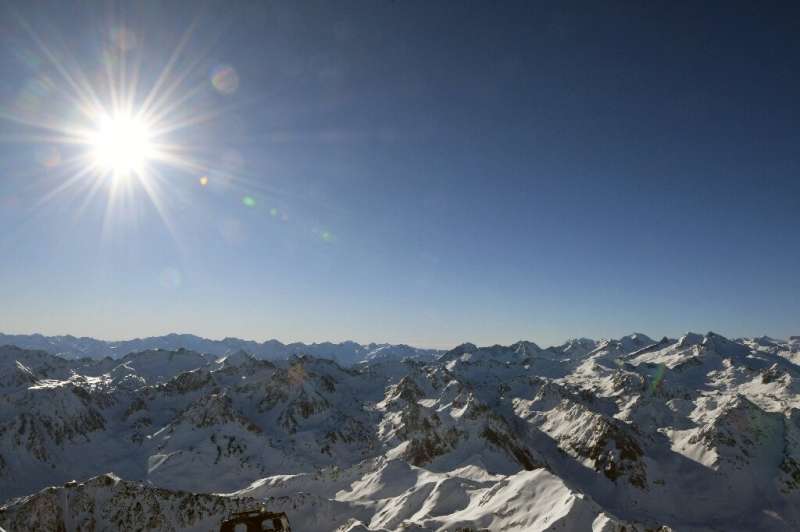Pyrenees glaciers 'doomed', experts warn

Glaciers nestled in the lofty crags of the Pyrenees mountains separating France and Spain could disappear within 30 years as temperatures rise, upending ecosystems while putting local economies at risk, scientists say.
"We can't set a precise date but the Pyrenees glaciers are doomed," Pierre Rene, a glaciologist with the region's Moraine glacier study association, told AFP.
He estimates the end will come by 2050, based on the group's measurements of nine of the 15 glaciers on the French side over the past 18 years.
The United Nations has said the past decade has been the hottest on record and warned that persistent greenhouse gas emissions were expected to push average global temperatures even higher, leading to retreating ice cover, rising sea levels and increasingly extreme weather.
It also confirmed that 2019 was the second hottest year on record, after 2016.
Surveys, core samples and GPS tracking of the Pyrenees glaciers all point to the same conclusions already noted at glaciers in the Alps and elsewhere: Warmer and drier winters appear to be inexorably shrinking and thinning the ice fields.
The total surface area of the nine glaciers tracked by Moraine now stands at 79 hectares (195 acres) compared with 140 hectares just 17 years ago, Rene said.
That is just a small fraction of the 450 hectares they covered in the middle of the 19th century—and the pace of decline is accelerating.
Since 2002, the nine glaciers have lost 3.6 hectares every year, the equivalent of five soccer pitches, Moraine says in its report on the 2019 season.
Last year was no exception, with the bottom edge of five glaciers tracked by Moraine retreating by 8.1 metres (27 feet) on average last summer, up from 7.9 metres recorded in previous years, it said.
'Wiped off the map'
Scientists also warn of the hit to high-altitude ecosystems and biodiversity, with consequences that will ripple well beyond the mountainous zones.
Glaciers and the cold rivers they feed harbour bacteria and fungi that have adapted to the harsh conditions, including the near-absence of light, said Sophie Cauvy-Fraunie, a researcher at the INRAE agricultural and environmental institute.
Microscopic algae also provides a first link in the food chain of glacier environments, sustaining glacial fleas and other insects.
As temperatures rise and more ground is exposed as the glaciers retreat, the landscape will become vulnerable to colonisation from plants and animals that currently can survive only at lower altitudes.
"If native species in the Pyrenees depend on glacial influences, you can imagine that they are going to be wiped off the map," Cauvy-Fraunie said.
The regional OPCC climate observatory estimated in a 2018 report that average maximum temperatures across the Pyrenees could rise by 1.4 to 3.3 degrees Celsius (2.5 to 4 Fahrenheit) by the middle of this century.
The increase has been even more dramatic at higher altitudes, where shrinking glaciers are seen as a harbinger of dire consequences across the range.
On the 2,870-metre (9,416-foot) Midi de Bigorre peak above the La Mongie ski resort—favoured by French President Emmanuel Macron—the average temperature has risen by 1.7 degrees since 1880, compared with a global average of 0.85 degrees, Moraine says.
Tourism affected
That could spell disaster for the roughly three dozen ski resorts on both the French and Spanish sides, as well as the popular stations in Andorra.
Already this year, around half of French resorts had to push back their scheduled openings before the Christmas holidays because of warm winds sweeping up from the south.
That came after a 2018-2019 season that saw the lowest snowfalls since regular measurements began 22 years earlier, according to the Meteo France weather service.
It took a heavy toll on tourism as lift ticket sales and hotel reservations plunged, with many skiers heading to higher slopes in the French Alps.
Already several glaciers have been reduced to little more than year-round snow packs, which will also impact the summer tourist season.
Rene said climbers will lose their "stepladders" for ascents to the highest peaks, "making their routes to the top more difficult".
And for hikers at lower elevations, the retreat will destabilise the newly exposed slopes, heightening the risk of rock falls or even avalanches.
© 2020 AFP



















